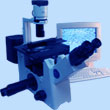
Methods of Investigation
for FP7 partners
and coordinators
|
|||
| Home | |||
| Cytotechnology Group | |||
| Staff | |||
| Methods | |||
| Projects | |||
| Research Results | |||
| Patents | |||
| Image Gallery | |||
| Cooperation | |||
| Contact Us | |||
The Agarose Hydrogel Protects Small Beta-Cell Clusters in Culture from Cytotoxic Factors |
|||||||||||||||||||||||||||||
|
24th Workshop of the AIDPIT Study Group. Innsbruck, Austria (January 23-25, 2005) THE AGAROSE HYDROGEL PROTECTS SMALL BETA-CELL CLUSTERS IN CULTURE FROM
IL-1-INDUCED APOPTOSIS Introduction. Human and rodent islets of Langerhans express Fas-L and show that under conditions when Fas is upregulated (i.e., after treatment of islets with IL-1b), apoptosis of islet cells increased. It could potentially accelerate islets rejection after transplantation. The encapsulation of beta-cells is a widespread method of cell protection from cellular and humoral destructive immune factors. That is why the aim of our research was to investigate the antiapoptotic properties of agarose hydrogel in respect of rat islets under influence of IL-1b.
THE AGAROSE HYDROGELS BARRIER PROTECTS BETA-CELLS FROM CYTOTOXIC FACTORS The microencapsulation of beta-cells is a wide-spread method of cell protection from destructive immune factors. The important requirement is optimal diffusion capability of microcapsule, which must provide both immunoisolation and permeability for trophogenes. Recently the importance of protection from soluble molecules (such as complement, interleukines, etc.) has increased due to achievement of higher levels of transplantat adaptation and hence increased interaction with fluids of organism. We investigated protective possibilities of agarose hydrogel in respect of insulinoma cells (Rinm5F) under influence of medium enriched with interleukin-1b (IL-1b) and/or C3-component of complement (C3). The monolayer of 4-days Rinm5F culture in cultural dishes was covered by agarose hydrogels layer about 40 µm thick or remained uncovered. RPMI1640 with 20% serum from patient with IDDM (initial IL-1b concentration < 5 pg/ml, C3 concentration 0.5 mg/ml) was added to cultural dishes. Some dishes in experimental groups were treated with 25 U/ml IL-1b or/and 1 mg/ml C3. After 24 h exposure the amount of undamaged cells was mesured by automatic videomicroscopical analysis with neutral red staining. The results of experiment are showed in table below.
*p<0.01 compared to covered by agarose hydrogel. Our results suggest that agarose hydrogel protects insulinoma cells from C3-amplified damage, especially under influence of serum from patient IDDM. We suppose that is caused by accessory influence of other complement components and destructive immune factors. In case of IL-1b exposure protective effect of hydrogel is expressed at lesser degree. |
|||||||||||||||||||||||||||||
| COOPERATION NEWS | ||
FP7 Programme involves subjects
|
||
| CURRENT RESEARCH | ||
|
||
| 2005-2007 © LBMI |



